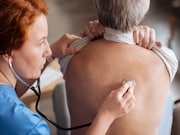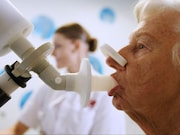Linagliptin Noninferior for CV Risk in Early Type 2 Diabetes
Linagliptin compared with glimepiride for risk for major cardiovascular events in T2DM with elevated CV risk
Anemia in Early Pregnancy May Harm Child Neurodevelopment
Odds for ASD, ADHD, intellectual disability increased with anemia diagnosed during first 30 weeks
12.6 Million in U.S. Could Benefit From Tx to Prevent Active TB
Revised NHANES-based estimate for prevalence of latent TB infection excludes those who report prior tx
Seniors Should Undergo Annual Cognitive Health Assessment
After MCI diagnosis, patients should be counseled on treatment options; support needed for partners
Polypill Strategy Promising in Socioeconomically Vulnerable
Greater reductions in systolic blood pressure, LDL cholesterol levels with polypill in minority population
Physical Therapy and Surgery Reduce Mixed Urinary Incontinence Symptoms
However, reduction in symptoms from addition of physical therapy may not be clinically important
Electronic Nose Analysis May Predict Response to Anti-PD-1 Therapy in NSCLC
Initial breath analysis predicts individual treatment response to anti-PD-1 therapy at three months
2002 to 2016 Saw Rise in Drug Abuse-Linked Infective Endocarditis
Patients were younger, more often white men, poorer, and had fewer comorbidities
Nonphysician Providers Rarely Interpret Diagnostic Images
Radiography and fluoroscopy were most common NPP-billed imaging services over all years
Aortic, Mitral Regurgitation Risk Up With Fluoroquinolone Use
Risk significantly increased for current use and recent use, but not past use within 61 to 365 days














